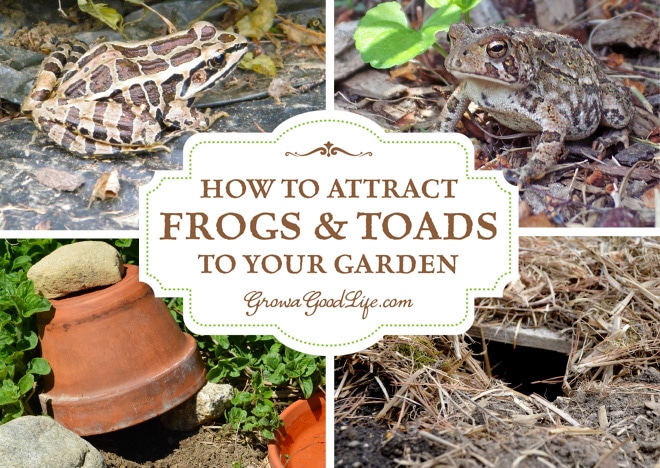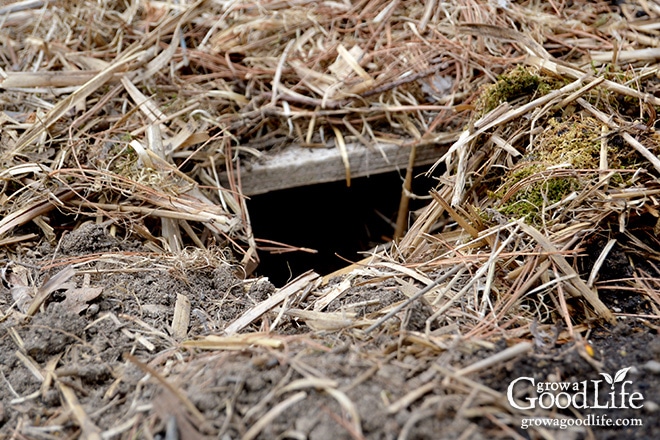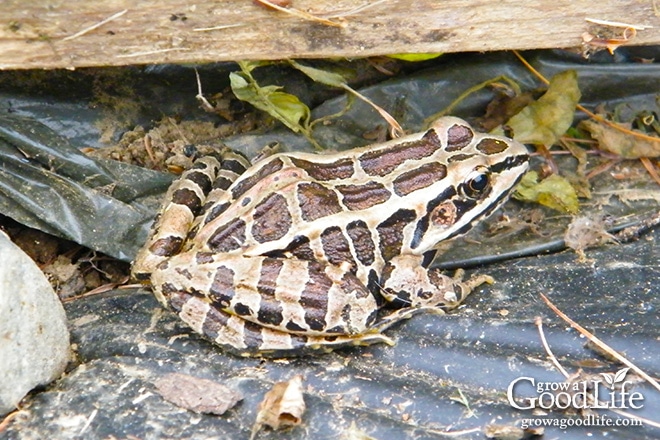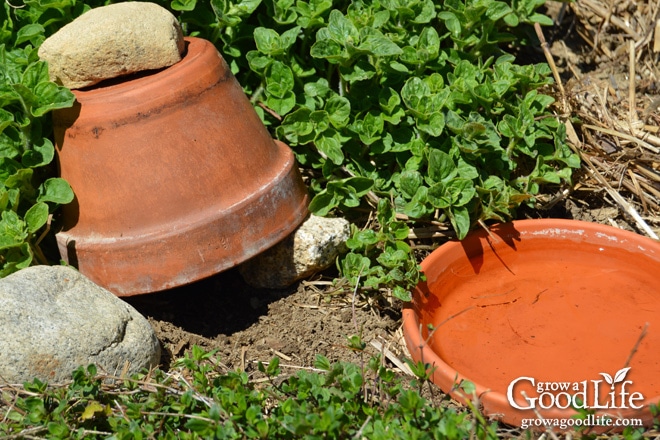How to Attract Frogs and Toads to Your Garden
This post may contain affiliate links, which means that I may receive a commission if you make a purchase using these links. As an Amazon Associate I earn from qualifying purchases.
Attracting and keeping frogs and toads in your garden will help reduce pest populations naturally without the need for pesticides. Here are some tips on how to attract and encourage frogs and toads to live in your garden.

Earlier this spring, I spotted a hole in the soil in one of my raised beds while walking the garden. When I returned a few days later, I saw that the hole was larger. Last year, I had a huge problem with voles in the garden that reduced my yield of potatoes and carrots.
“Not this year!” I thought as I inspected the hole with my gloved hand. I pulled away some of the soil from the edge of the hole and spotted something grey inside. I grabbed my garden trowel and dug down beneath the grey thing and carefully lifted it up. The grey blob was covered with dirt, but moved every so slightly. I almost screamed, but I was determined to figure out what it was. I dropped the shovel full of soil and grabbed the grey thing with my gloved hands. It took a few seconds for me to identify it. As the soil dropped away, I saw that it was a rather large toad!
It wasn’t moving much, and its eyes were closed tight. I looked it over carefully and was so glad I didn’t hurt it with my garden trowel. I carved out a shallow hole and placed the toad back into the ground while I searched the yard for a rock or piece of wood to use as a roof for the temporary toad home. When I returned and peered into the hole, I was astounded to see that the toad was gone! I found it again when I poked into the loose soil. It buried itself that quickly and blended with the soil. I placed the roof over the hole to leaving a small opening and covered it with last year’s straw.

I checked on the toad a day later and spotted it at the entrance of the opening warming itself in the spring sunshine. After shaking the winter hibernation sleepiness, the toad will return to its birthplace to spawn. This toad will probably hop to the edge of the yard and down the bank to a small stream that winds through the woods. I hope it makes it back to the garden for the summer.
Why You WANT Frogs and Toads in Your Garden
Frogs and toads are both amphibians and belong to the Anura order. Although they are similar, frogs and toads are easily distinguished by certain traits. Toads have dry, bumpy skin and spend most of their lives on land. In winter, toads hibernate on land beneath the frost line. They burrow down in the soil using their back legs.

Frogs have moist smooth skin and spend most of their lives in or near water. When I started gardening, my first amphibian friend was a pickerel frog. I was surprised to learn that frogs don’t spend all of their time in water, but will venture out to grassy areas in search of food. This one stayed in the garden all summer hiding away under boards and in between the foliage in the herb garden. It would startle me once in a while by jumping out of the foliage when I disturbed its hiding place. In the winter, Pickerel frogs hibernate in the mud debris and silt of ponds or streams.

Both frogs and toads are beneficial to the garden because they feed on many pests such as, bugs, beetles, caterpillars, cutworms, grasshoppers, grubs, slugs, and a variety of other pests. A single frog can eat over 100 insects in one night. Attracting and keeping frogs and toads in your garden will help moderate pest populations without the need for chemical or natural pesticides.
How to Attract Frogs and Toads to Your Garden
If you have a pond, brook, or water feature near you, you probably have frogs and toads nearby. Here are some of the ways to attract them to your garden and invite them to stay:
Eliminate Chemicals: Pesticides, synthetic fertilizers, and herbicides can poison frogs and toads. Frogs and toads breathe and drink through their skin. Eliminate chemicals and garden organically. Build healthy soil, companion plant, and use crop rotation and organic gardening techniques. Encouraging frogs or toads to stay in your garden will take care of any insects naturally.
Offer Shelter: Most toads and frogs are nocturnal and avoid sun to prevent dehydration. They prefer damp, shady areas and need shelter to hide from predators and escape the heat from the daytime sun. Create a shelter by arranging stones into a small cave. You can also use a clay or ceramic flowerpot as housing. Turn the pot upside down and prop it up with rocks leaving enough room for the frog or toad to slip inside. Locate your shelter in a quiet area that has a lot of shade.

Provide Water: Toads and frogs don’t drink through their mouth. Instead, they absorb moisture into their bodies by sitting in water. Place several shallow containers of water in the shade near the shelter. Rinse the containers out at least once week and fill with fresh water. Tanya at Lovely Greens built a small wildlife pond to attract frogs to her garden.
Attracting and encouraging toads and frogs to live in your garden keeps the pest population down and reduces the need for pesticides or other natural insect deterrents. Just one frog or toad can eat up to 10,000 pests during the garden season. Toads and frogs will often return to the same location from year to year as long as the environment is pleasant and there is plenty to eat.
Resources:
- Bradford, Alina. “Facts About Frogs & Toads.” LiveScience. TechMedia Network, May 1, 2015. Web. May 7, 2016.
- Smolowe, Laura. “Who Is the Pickerel Frog?” Herpetology Species. Yale University, 2000. Web. May 7, 2016.
- “Toads – National Wildlife Federation.” Toads – National Wildlife Federation. Web. May 7, 2016.
Caution: You may not want to encourage frogs and toads to stay if you have dogs that enjoy hunting down toads. As a defense mechanism against predators, most toads release skin secretions which produce a foul-smelling odor and can be toxic to dogs and other animals.
You May Also Like:
- 5 Ways Organic Mulch Helps Your Garden
- 7 Herbs to Start From Seed
- 20 Garden Mulching Tips from Seasoned Growers
- 7 Tips to Prepare Your Garden for Winter
Good planning is key to a successful vegetable garden
Whether you are new to growing your own food or have been growing a vegetable garden for years, you will benefit from some planning each year. You will find everything you need to organize and plan your vegetable garden in my PDF eBook, Grow a Good Life Guide to Planning Your Vegetable Garden.



What size clay pot and saucer were used in the photo?
Steve, In the photo, I used a 10-inch terracotta pot and a matching 12-inch saucer. Aim for a pot that is at least 8-12 inches in diameter. These sizes work well to create a cozy and effective toad or frog shelter. Make sure to also use a saucer or container that can hold a bit of fresh water, helping to keep the environment moist, which is essential for toads and frogs.
How can I make a suitable outdoor home for frogs and toads without inviting snakes in?
Ariana, You really can’t. Snakes will be attracted to the same environment. If you have poisonous snakes in your area, it is best to not encourage them to live in your garden.
I’m trying to attract toads with shelter and water, but no one has come by yet. How will they know its there? All I have now is a bunch of mosquitoes breeding and no one to eat them 🙁
Lisa, Do you have water nearby?
How do I get frogs away from my front door light and from behind my front window shutters. A few (2) live behind my front window shutters and front door light. They have jumped into the house from the front door light. This is unpleasant as they then move fast away and then die from lack of water and food in the house. Is there any natural product that will chase them away and back into the dirt garden?
Arlene, Insects are attracted to the light and frogs tend to gather where there is food. If you don’t want them near your front door, turn off your light. You could add a solar light to the garden to encourage the frogs to stay there.
Hi
I just read this sweet article. I love toads and frogs. I discovered a toad last summer but only saw it once. I didn’t realize they burrow in the ground. That might of been what was doing that in one corner and I too thought it was a vole. Tomorrow I’ll make a spot for one and see if it’ll return. I’m concerned though with putting water out cos of mosquitoes I don’t want them laying eggs and multiplying!
Which is why the article said to refresh water frequently. This will deture mosquitos.